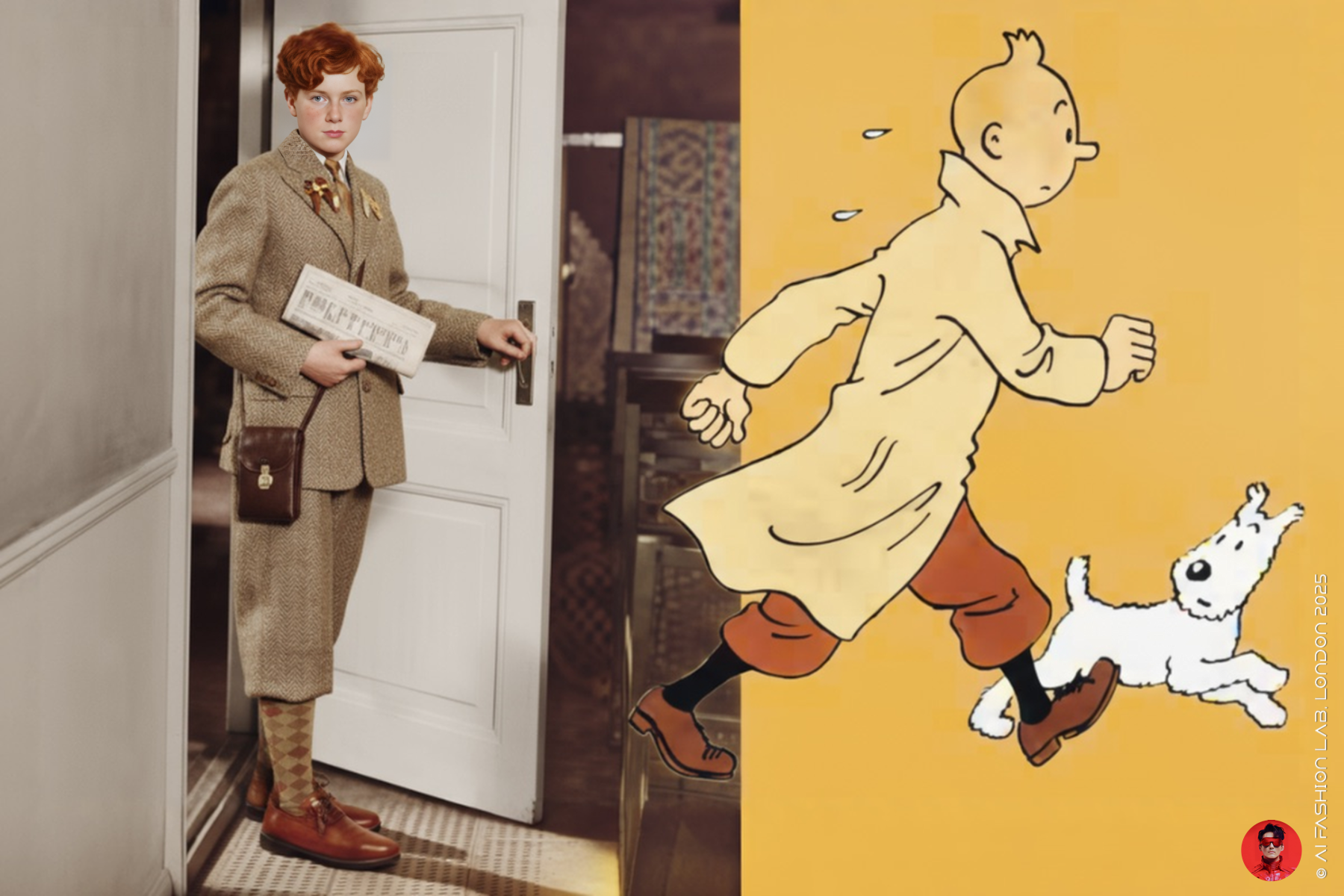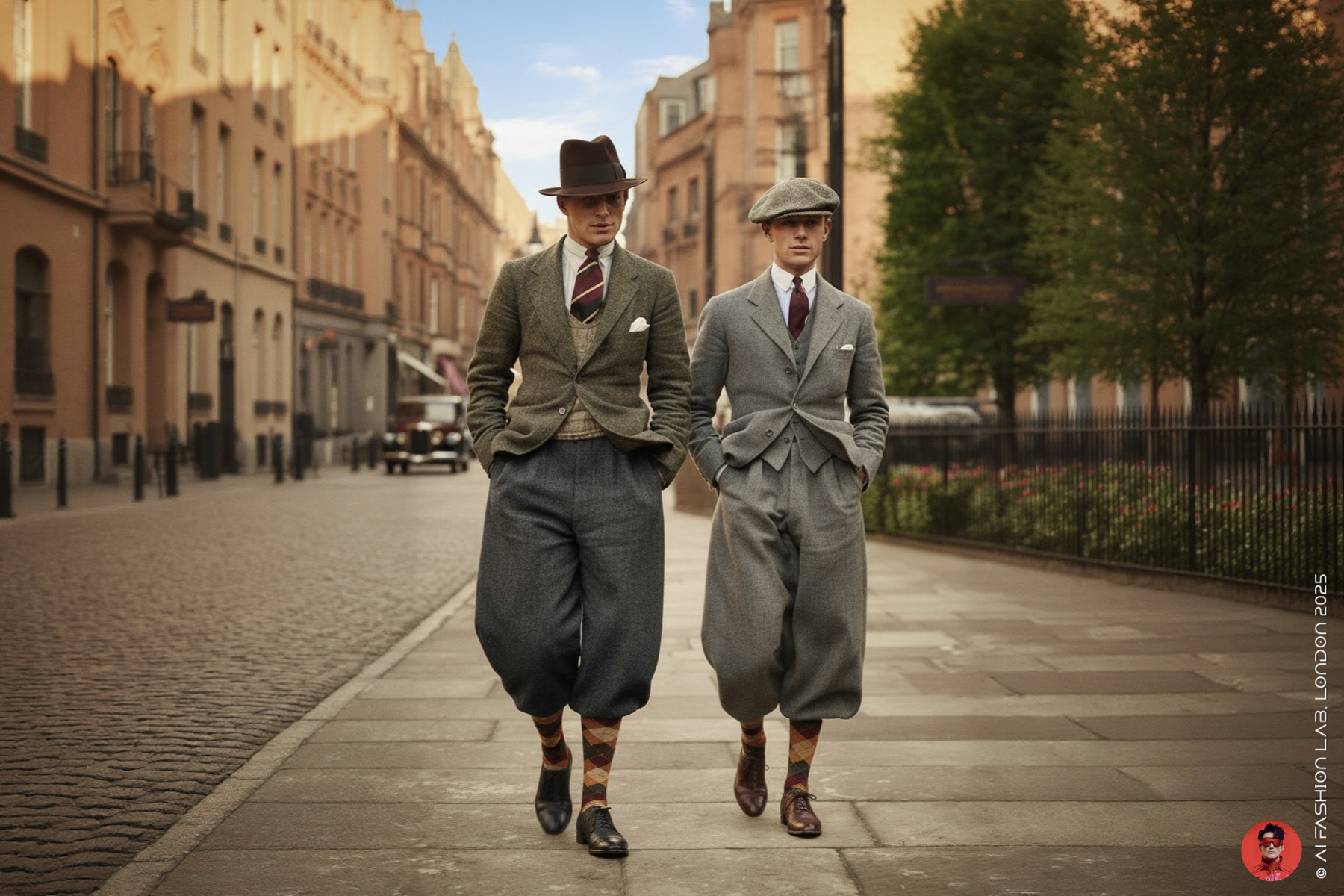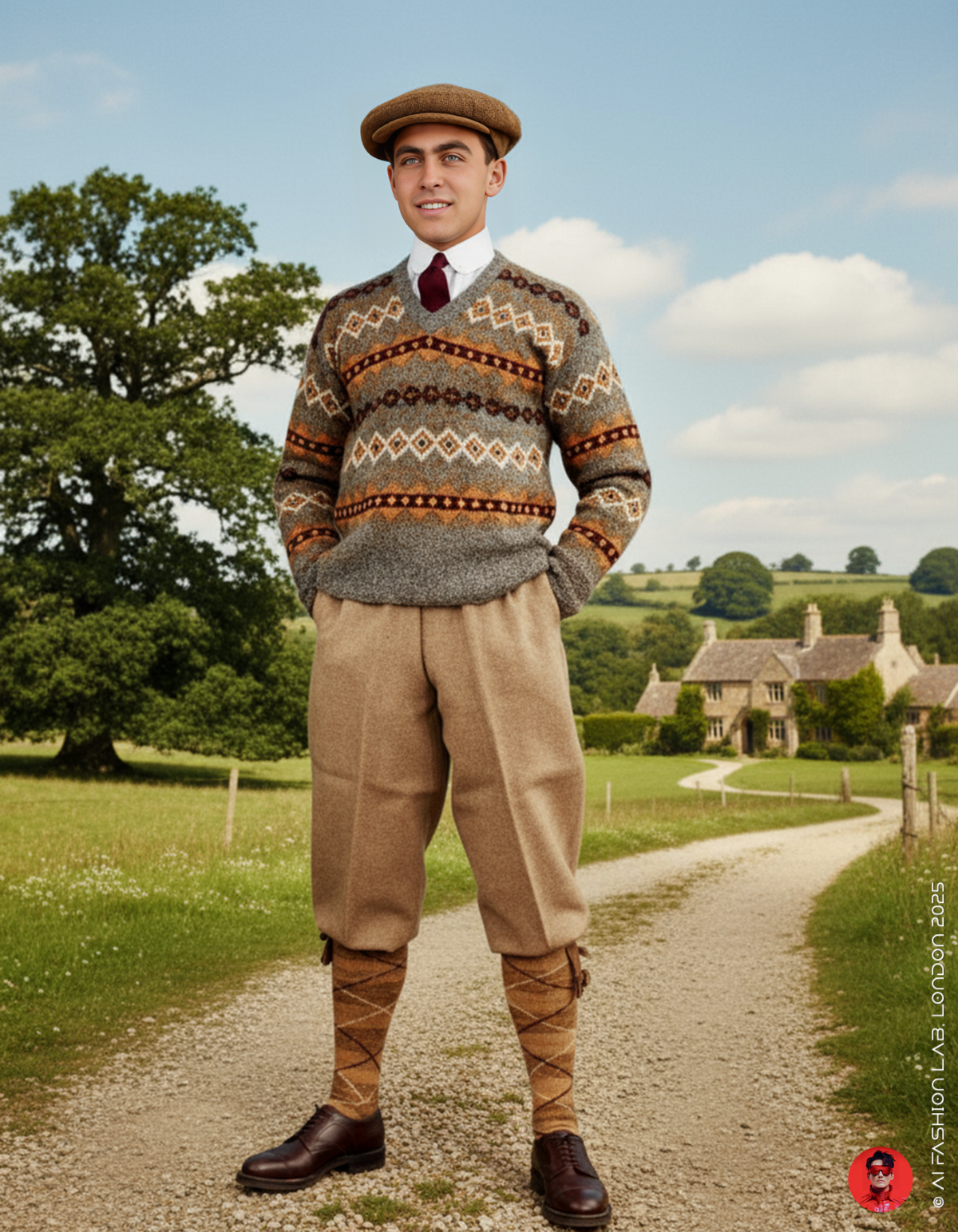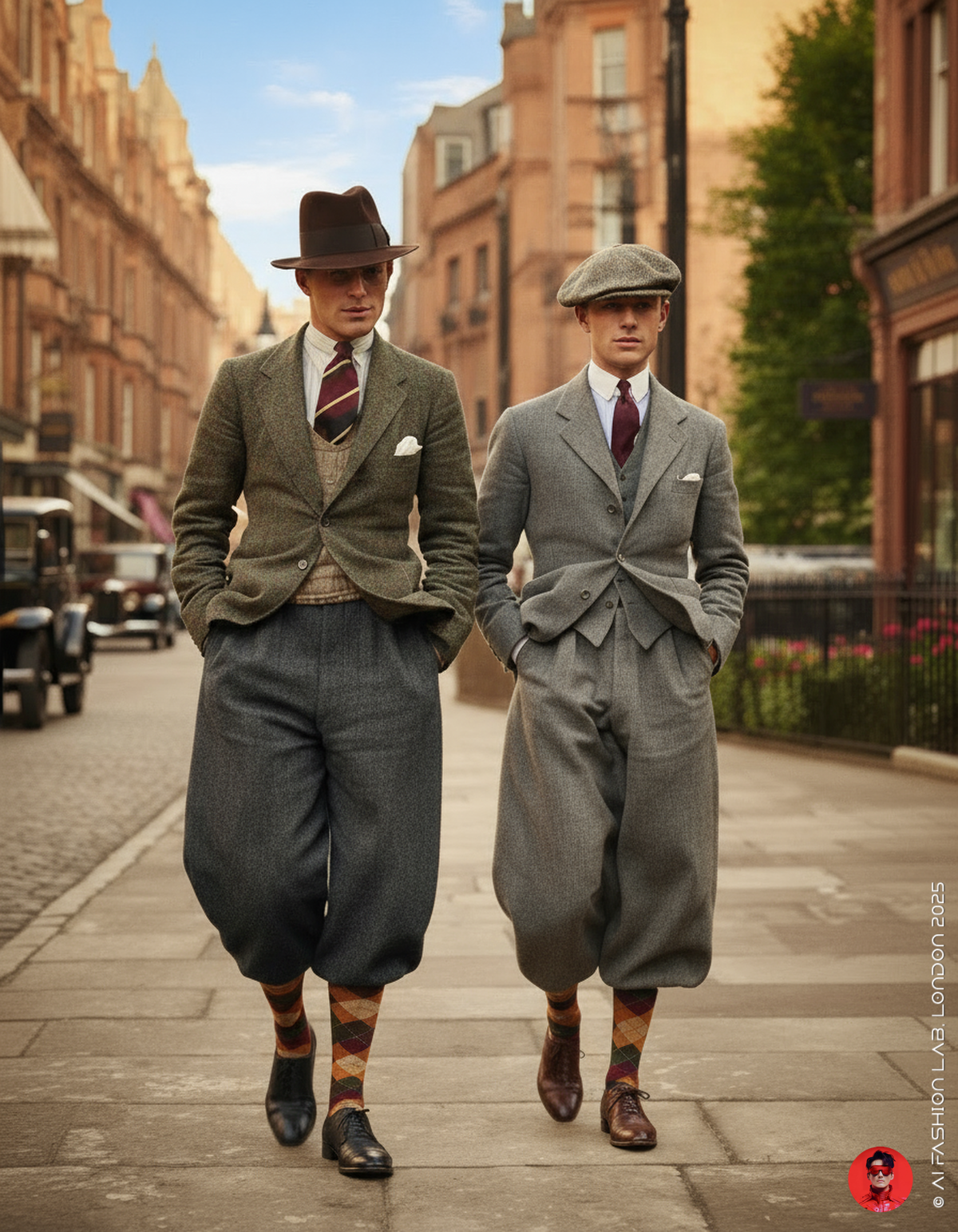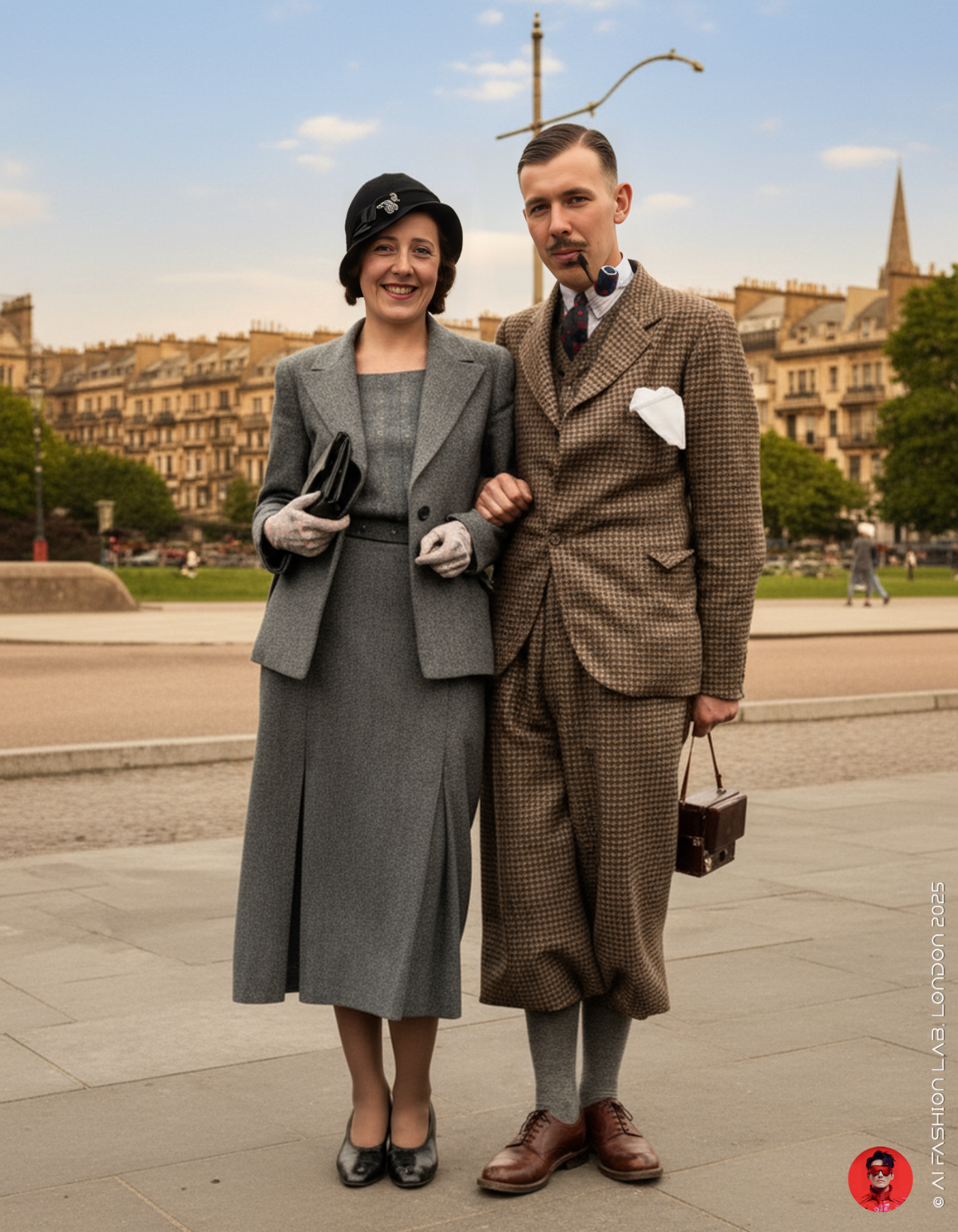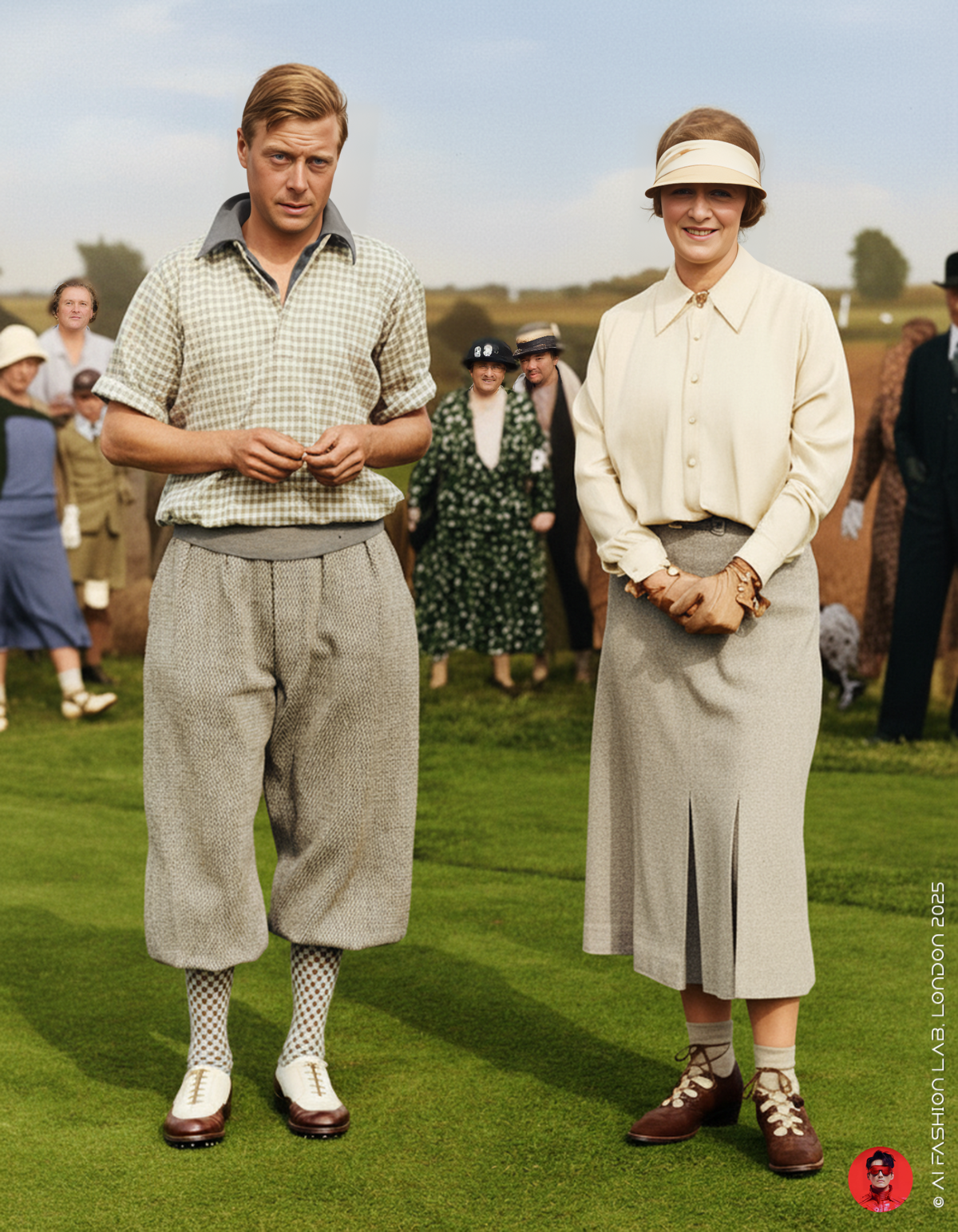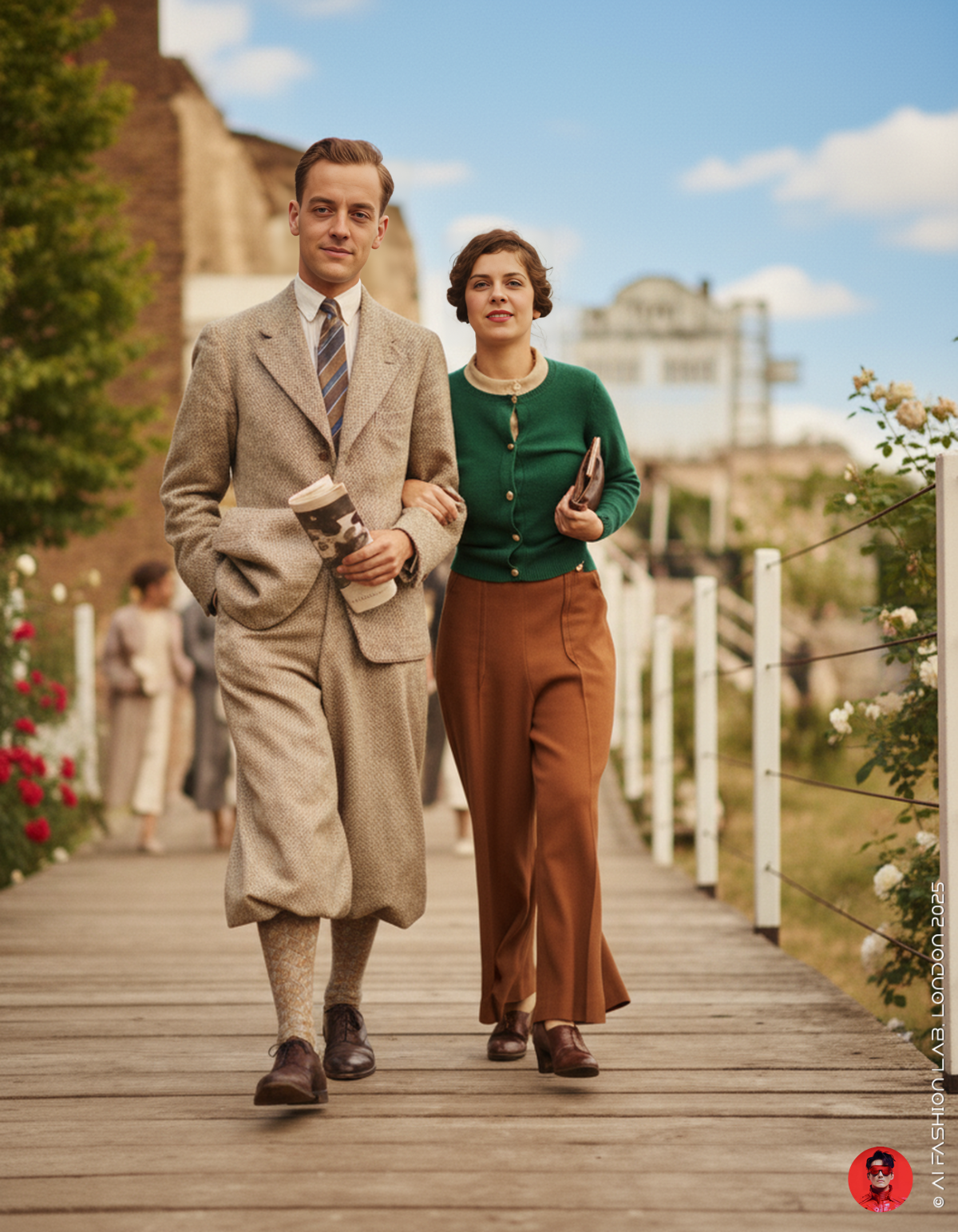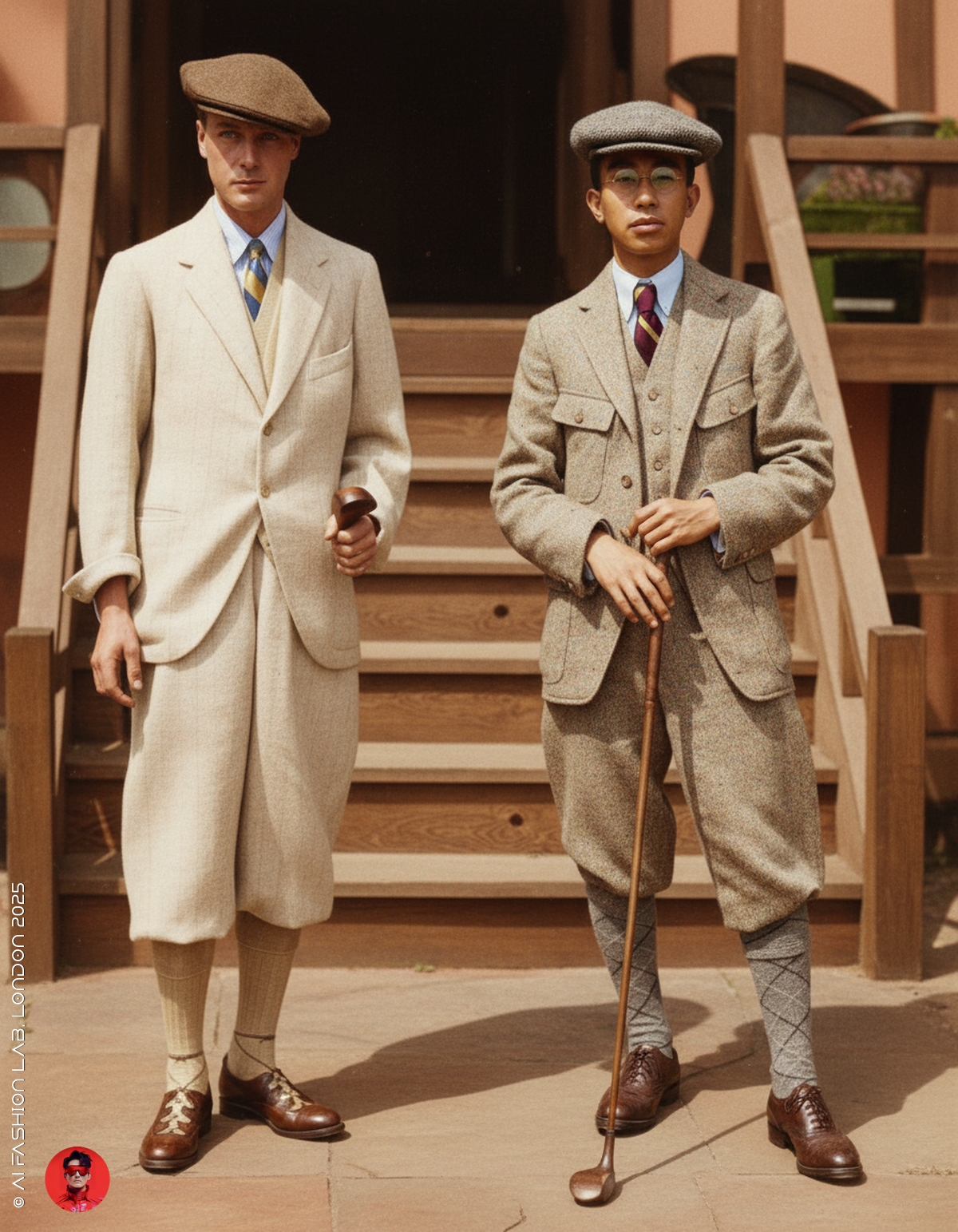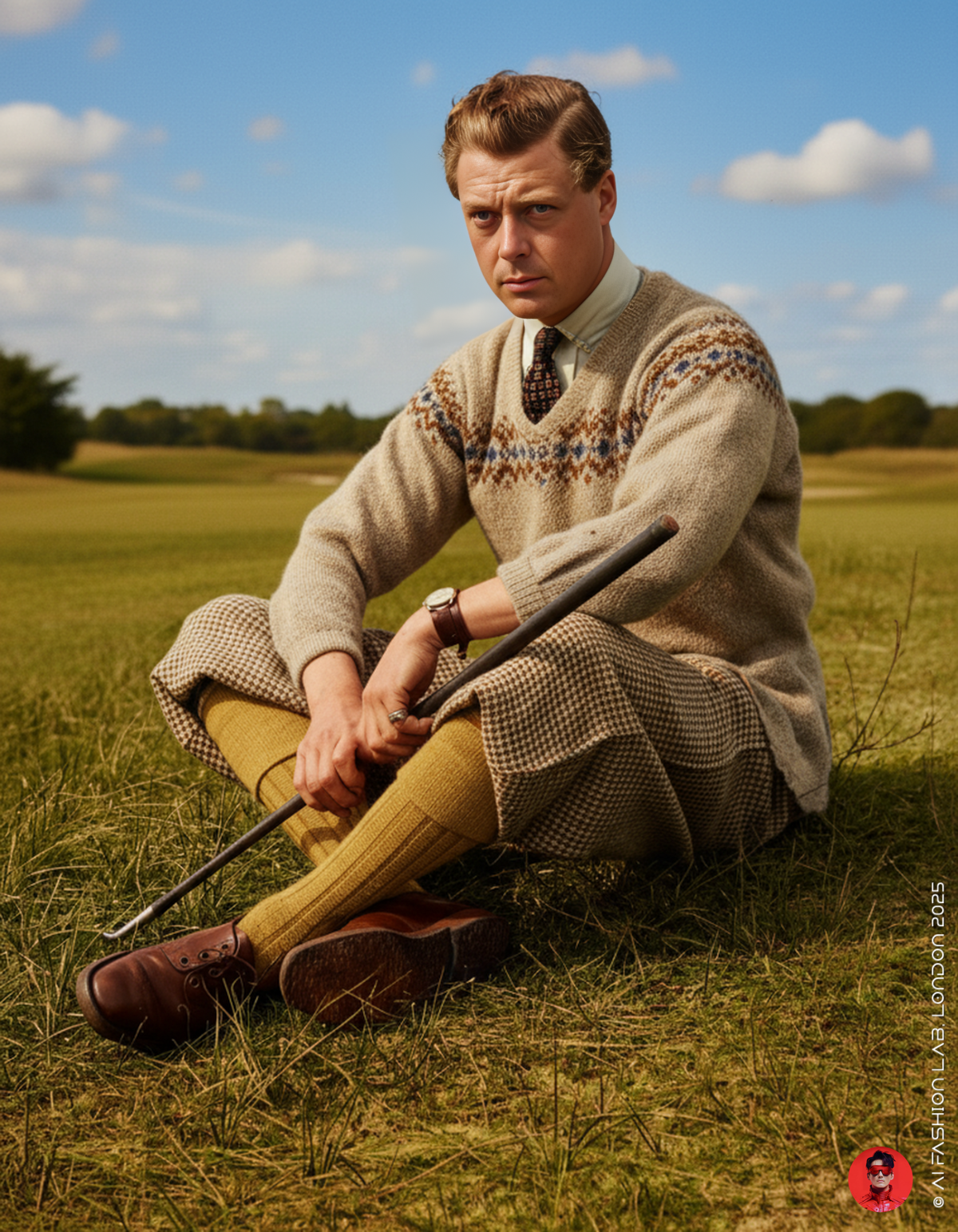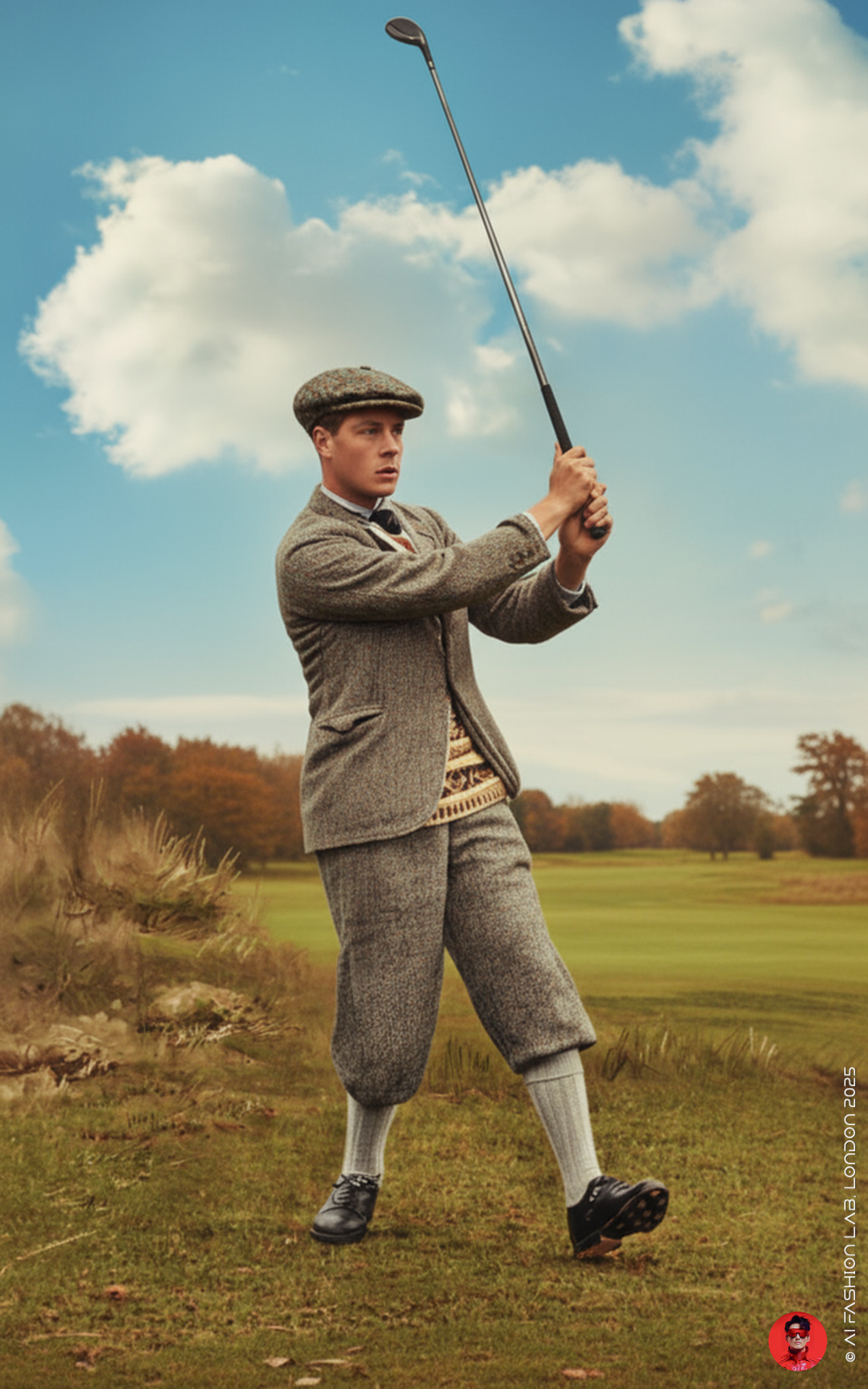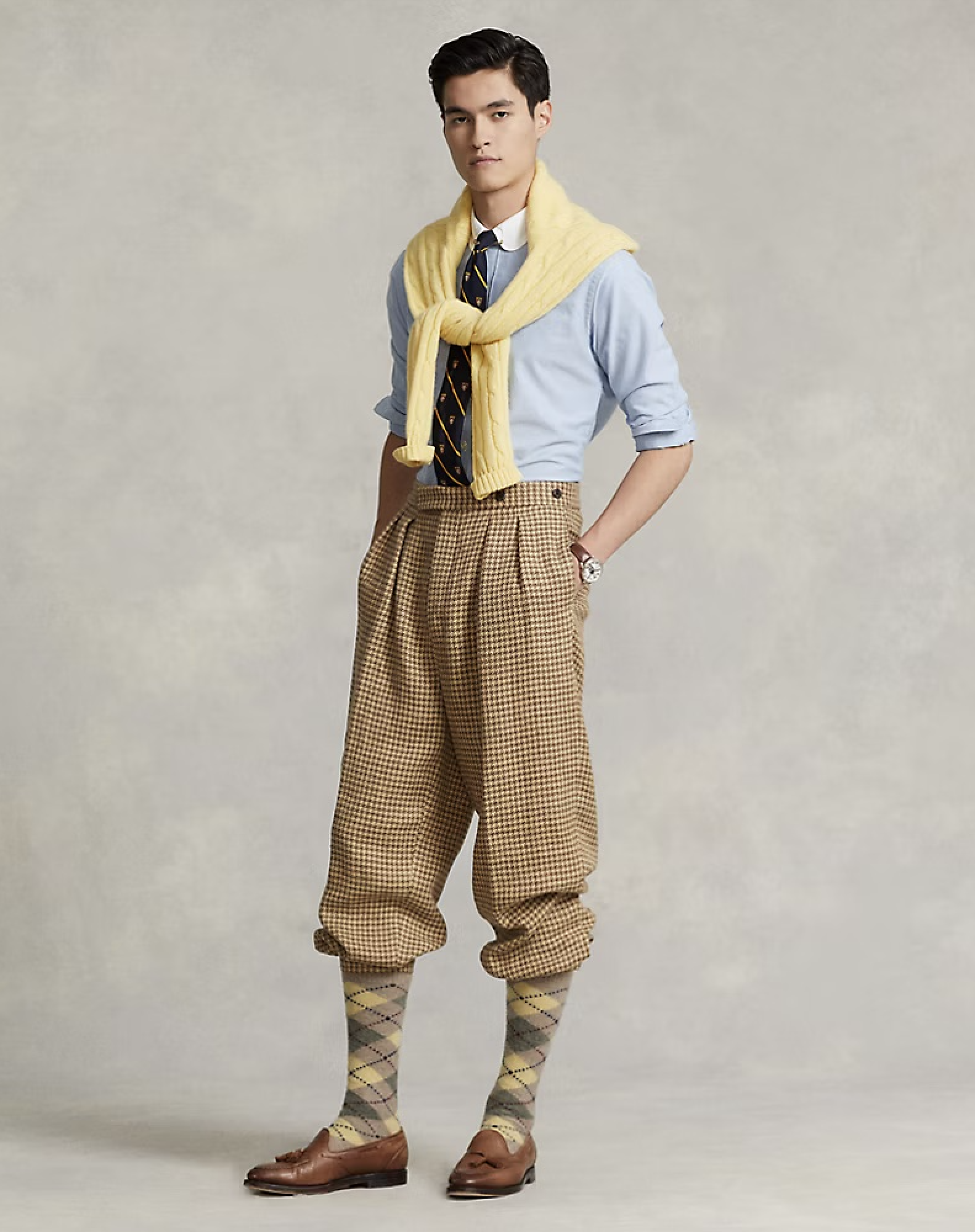แฟชั่นกางเกง “พลัสโฟร์” (Plus Four) ในประวัติศาสตร์ราชวงศ์และแฟชั่นโลก
แฟชั่นกางเกง “พลัสโฟร์” (Plus Four) ในประวัติศาสตร์ราชวงศ์และแฟชั่นโลก
ในบรรดาภาพถ่ายที่ได้รับการบูรณะจากโครงการฟื้นฟูพระรูปเจ้านายไทยผู้เคยไปทรงศึกษาที่โรงเรียนแฮร์โรว์ มีอยู่ภาพหนึ่งที่สะท้อนความรุ่งเรืองของแฟชั่นโลกในทศวรรษ 1920 ได้อย่างเด่นชัด คือภาพของ พระเจ้าวรวงศ์เธอ พระองค์เจ้าจุมภฏพงษ์ บริพัตร กรมหมื่นนครสวรรค์ศักดิพินิต ในช่วง พ.ศ. 2469–2472 (ค.ศ. 1926–1929) ฉลองพระองค์ด้วยกางเกง “พลัสโฟร์” (Plus Four) ซึ่งเป็นแฟชั่นที่กำลังฮิตอย่างยิ่งในยุคนั้น โดยมี เจ้าชายเอ็ดเวิร์ด เจ้าชายแห่งเวลส์ (ต่อมาคือสมเด็จพระเจ้าเอ็ดเวิร์ดที่ 8 แห่งสหราชอาณาจักร) เป็นผู้นำกระแส จนกลายเป็นที่นิยมทั้งในยุโรปและอเมริกา
ความนิยมของกางเกงพลัสโฟร์ไม่ได้เสื่อมคลายไปอย่างรวดเร็ว หากแต่ยังคงได้รับความนิยมต่อเนื่องเข้าสู่ทศวรรษ 1930 ดังจะเห็นได้จากพระบรมฉายาลักษณ์ของ สมเด็จพระเจ้าอนันทมหิดล รัชกาลที่ 8 ขณะยังทรงพระเยาว์ เมื่อครั้งประทับ ณ เมืองโลซานน์ ประเทศสวิตเซอร์แลนด์ ภาพนี้ถ่ายในปี ค.ศ. 1935 (พ.ศ. 2477–2478) และเก็บรักษาอยู่ใน LIFE Photo Collectionแสดงให้เห็นว่าพระองค์ก็ทรงฉลองพระองค์ด้วยกางเกงพลัสโฟร์เช่นเดียวกัน สะท้อนความต่อเนื่องของแฟชั่นสมัยใหม่ที่พระบรมวงศ์ชั้นสูงของไทยได้ทรงรับไว้
ความแพร่หลายของแฟชั่นนี้ยังสะท้อนให้เห็นในภาพถ่ายสำคัญอีกภาพหนึ่ง ในปี ค.ศ. 1922 (พ.ศ. 2465) เจ้าชายเอ็ดเวิร์ดเสด็จประพาสตะวันออกไกล โดยได้เสด็จเยือนประเทศญี่ปุ่น และเสด็จไปยัง โตเกียวกอล์ฟคลับ (Tokyo Golf Club) ที่นั่นมีภาพถ่ายร่วมกับ มกุฎราชกุมารฮิโรฮิโตะ (ต่อมาคือจักรพรรดิโชวะ) ทั้งสองพระองค์ทรงฉลองพระองค์ด้วยกางเกงพลัสโฟร์ในสไตล์สปอร์ตอันทันสมัย การเสด็จเยือนครั้งนี้ซึ่งรวมถึงอินเดีย เอเชียตะวันออกเฉียงใต้ และญี่ปุ่น ช่วยเผยแพร่ภาพลักษณ์ความเป็นผู้นำแฟชั่นระดับโลกของเจ้าชายเอ็ดเวิร์ดไปทั่วภูมิภาค
คำว่า Plus Four หมายถึงกางเกงที่ยาวเลยเข่าออกไปสี่นิ้ว แตกต่างจาก Plus Two, Plus Eight และกางเกงแบบ Knickerbocker ดั้งเดิม กางเกงพลัสโฟร์ถูกเผยแพร่ในอเมริกาโดยเจ้าชายเอ็ดเวิร์ดระหว่างการเสด็จเยือนทางการทูตในปี ค.ศ. 1924 (พ.ศ. 2467) และกลายเป็นที่นิยมในฐานะแฟชั่นที่สะท้อนความผ่อนคลายและความเป็นอิสระในยุคแจ๊ซ กางเกงชนิดนี้มักสวมคู่กับถุงเท้าอาร์ไกล์ (argyle socks) เนกไทผ้าไหม เสื้อเชิ้ต และเสื้อสเวตเตอร์ อีกทั้งยังมีการสวมเป็นสูทเต็มชุด ดังเช่นที่นักดนตรีชื่อดัง หลุยส์ อาร์มสตรอง (Louis Armstrong) เคยสวมใส่
เดิมทีพลัสโฟร์ออกแบบมาเพื่อการกีฬาและกิจกรรมกลางแจ้ง โดยนิยมสวมเป็นส่วนหนึ่งของชุด Norfolk suit ตัดเย็บด้วยผ้าทวีดหรือผ้าลายตาราง เหมาะกับสภาพอากาศหนาวชื้นของอังกฤษ ต่อมากางเกงชนิดนี้ก็กลายเป็นแฟชั่นในตัวเอง ไม่จำกัดอยู่แค่การล่าสัตว์หรือเล่นกีฬาอีกต่อไป
กางเกงพลัสโฟร์ยังถูกทำให้เป็นอมตะในวัฒนธรรมสมัยนิยมผ่านตัวละคร ตินติน (Tintin) ของนักเขียนการ์ตูน แอร์เช่ (Hergé) ซึ่งได้แรงบันดาลใจจาก พาลเล ฮูลด์ (Palle Huld) เด็กหนุ่มชาวเดนมาร์กผู้เดินทางรอบโลกในปี ค.ศ. 1928 (พ.ศ. 2471) เพื่อรำลึกถึงวรรณกรรม Around the World in 80 Days ของ ฌูล เวิร์น (Jules Verne) และแต่งกายด้วยพลัสโฟร์ตลอดการเดินทาง
ทุกวันนี้ พลัสโฟร์ยังคงปรากฏในโลกของกีฬากอล์ฟมากที่สุด ซึ่งสะท้อนถึงภาพลักษณ์แห่งความสปอร์ตและความรื่นรมย์กลางแจ้ง กางเกงทรงพองและถุงเท้าลายตารางกลายเป็นสัญลักษณ์ของยุคที่แฟชั่นเชื่อมโยงกับเสรีภาพ และยังเป็นที่ระลึกถึงช่วงเวลาที่เจ้านายฝ่ายตะวันตกและตะวันออก — ตั้งแต่ พระองค์เจ้าจุมภฏพงษ์ บริพัตร ไปจนถึง สมเด็จพระเจ้าอนันทมหิดล รัชกาลที่ 8 — ต่างก็ทรงรับเอาสไตล์อันทันสมัยของกางเกงพลัสโฟร์ไว้เช่นกัน
นอกจากนี้ ยังแสดงให้เห็นว่ากางเกงพลัสโฟร์ไม่ได้ถูกจำกัดอยู่ในอดีต เพราะในโลกแฟชั่นร่วมสมัย Ralph Lauren ได้หยิบยกกางเกงพลัสโฟร์กลับมาเป็นส่วนหนึ่งของคอลเลกชันสุภาพบุรุษฤดูใบไม้ผลิ/ฤดูร้อน ค.ศ. 2025 (พ.ศ. 2568) ยืนยันว่ากางเกงชนิดนี้ยังคงเป็นสัญลักษณ์ของความคลาสสิกที่ถูกตีความใหม่อยู่เสมอในรันเวย์ระดับโลก
The Plus Four in Royal and Fashion History
Among the many photographs restored from the archives of Thai princes who studied in Harrow, one image stands out as a testament to the height of 1920s fashion. It depicts Prince Chumbhotpong Paripatra (พระเจ้าวรวงศ์เธอ พระองค์เจ้าจุมภฏพงษ์ บริพัตร กรมหมื่นนครสวรรค์ศักดิพินิต) during the years พ.ศ. ๒๔๖๙–๒๔๗๒ (1926–1929), dressed in the latest Plus Four trousers. This style, immensely fashionable at the time, had been popularised by Edward, Prince of Wales(later King Edward VIII), whose trendsetting looks took Europe and America by storm.
The appeal of the Plus Four did not fade quickly. It continued to be worn well into the 1930s, as shown in a remarkable photograph of the young Prince Ananda Mahidol (พระบาทสมเด็จพระปรเมนทรมหาอานันทมหิดล พระอัฐมรามาธิบดินทร), later King Rama VIII of Thailand, taken while he was living in Lausanne, Switzerland. The photograph, dated ค.ศ. 1935 (พ.ศ. ๒๔๗๗–๒๔๗๘) and preserved in the LIFE Photo Collection, shows the future king also wearing the iconic Plus Four ensemble, linking generations of Thai royalty with one of the most fashionable looks of the interwar period.
The international resonance of this style is evident in other images from the era. In 1922, during his Far East tour, Edward, Prince of Wales, visited Tokyo Golf Club, where he was photographed with Crown Prince Hirohito (later Emperor Shōwa). The visit, part of a journey that also took him through India, Southeast Asia, and Japan, helped project the modern British sporting style into Asia. Edward’s choice of attire on that occasion — Plus Fours with golf socks and sweater — reinforced his reputation as a global fashion leader and cemented the look’s association with cosmopolitan leisure.
The term Plus Four itself refers to trousers extending four inches below the knee, distinguished from the shorter Plus Two, the longer Plus Eight, and the more traditional Knickerbocker. Edward, Prince of Wales, introduced the style to America during a diplomatic trip in 1924, where it was welcomed as part of the looser, more relaxed clothing of the Jazz Age. Typically paired with argyle socks, silk neckties, dress shirts, and sweaters, the trousers could also form part of a complete suit. Famous figures like Louis Armstrong were photographed in full Plus Four ensembles.
Initially designed for sports and the outdoors, the trousers proved especially practical for hunting when matched with the Norfolk suit, a sturdy tweed or plaid outfit suited to England’s damp weather. The look soon transcended functionality and became fashionable in its own right.
Cultural history further cemented the Plus Four’s place in collective memory. The style was immortalised by Tintin, the comic book hero created by Hergé, whose look was inspired by Palle Huld, a Danish teenager who travelled the globe in 1928 to re-enact Jules Verne’s Around the World in 80 Days. Dressed in Plus Fours, Huld’s image inspired the youthful, adventurous silhouette of Tintin.
Today, the Plus Four survives most recognisably in the world of golf, where its association with sports and leisure endures. The puffed trousers and patterned socks remain a playful homage to an era when fashion met freedom, and when young princes of East and West alike — from Prince Chumbhotpong Paripatra to Prince Ananda Mahidol — embraced this most modern of 1920s and 1930s styles.
Moreover, this demonstrates that the Plus Four is by no means confined to the past. In contemporary fashion, Ralph Lauren has revived the trousers as part of his Spring/Summer 2025 men’s collection (B.E. 2568), reaffirming that the style endures as a timeless classic — continually reinterpreted on the world’s runways.
#aifashionlab #AI #aiartist #aiart #aifashion #aifashiondesign #aifashionstyling #aifashiondesigner #fashion #fashionhistory #historyoffashion #fashionstyling #fashionphotography #digitalfashiondesign #digitalcostumedesign #digitaldesign #digitalaiart #ThaiFashionHistory #ThaiFashionAI #thailand



